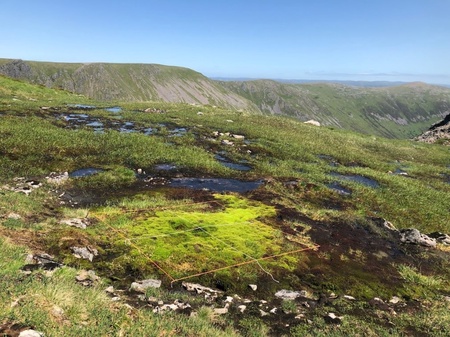The title of our project was “Patterns and drivers of change in the alpine plant communities of Creag Meagaidh NNR”. This meant we were looking at how the plant communities of this mountain range have changed in relation to climate change, deer grazing, and nitrogen deposition. We used information from plots first surveyed in the 1950s by Donald McVean and Derek Ratcliffe from their study “Plant Communities of the Scottish Highlands”.
Experiences during our Fieldwork
This project, at first, seemed a lot to take on. But, as we progressed in planning, we both became very excited about the project. It wasn’t until we both sat in the car and drove from Aberdeen to Aviemore that it sank in. The first 3 days in the mountains were very challenging as we still had a lot to learn. But like always, starting something new can be challenging. Thankfully our project supervisor, Dr Louise Ross, accompanied us on our first day up the mountains and helped us get started. It came down to adapting each day to overcome any difficulties we faced. For example, for plant species we couldn’t identify we would take a photo and give it a nickname so when we returned home we could then correctly identify it. As we became more familiar with the process of relocating the plots, identifying and quantifying the different plant species, we became faster and more confident in what we were doing. We spent a total of 7 days in the mountains, camped 4 nights, and managed to complete all 23 plots in the time we set. We totally enjoyed the experience, and the landscapes were amazing!
Preparation
You need a lot of preparation! Like most fieldwork, preparation was key to ensuring everything would be completed correctly. Our preparation included fieldwork risk assessment, car rental, liaising with landowners, accommodation, organising fieldwork and camping equipment, and planning the routes through the mountains. We started preparations months in advance to ensure we missed nothing.
Why was our study relevant?
Quantifying and characterising change in alpine plant communities will tell us how they are responding to anthropogenic environmental change. The results of our study will feed into a larger database, collected by researchers at the James Hutton Institute and Dr Louise Ross from SBS, on plant community change across the Scottish Highlands, and contribute to the conservation management of this valuable habitat. With COP26 just round the corner, the study is more important than ever in providing evidence of climate change impacts on biodiversity.
What we learned
Apart from becoming more interested in alpine plants, we learnt a lot of useful skills! From navigation and plant identification to simple methods of collecting valuable data with very little equipment. The Scottish Highlands are amazing and we absolutely valued the peacefulness up in the mountains.
Also don’t carry a 50kg rucksack up the hill. There was “NO” precarious terrain, only very steep slopes. Midges are annoying. Horseflies are super annoying. Deerflies can help you run up mountains more quickly (they are scarier than Horseflies!). Being in the mountains can magically make pencils reappear.



A great blog and thanks for the lessons learned- we don't share what does and does not work enough so we all repeat the same mistakes